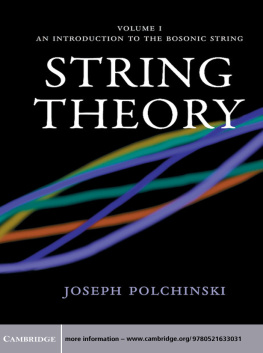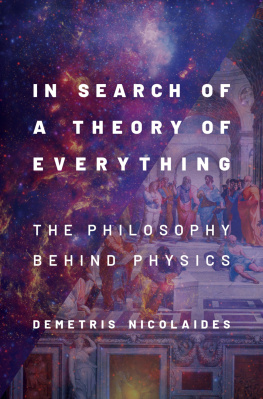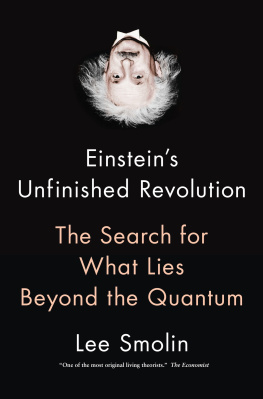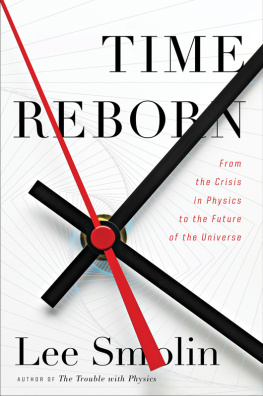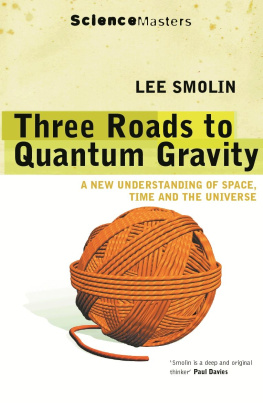A MARINER BOOK
HOUGHTON MIFFLIN COMPANY
BOSTON NEW YORK
To Kai
First Mariner Books edition 2007
Copyright 2006 by Spin Networks, Ltd.
ALL RIGHTS RESERVED
For information about permission to reproduce selections from
this book, write to Permissions, Houghton Mifflin Company,
215 Park Avenue South, New York, New York 10003.
Visit our website: www.houghtonmifflinbooks.com.
Library of Congress Cataloging-in-Publication Data
Smolin, Lee, date.
The trouble with physics : the rise of string theory,
the fall of a science, and what comes next / Lee Smolin.
p. cm.
Includes bibliographical references and index.
ISBN -13: 978-0-618-55105-7
ISBN -10: 0-618-55105-0
1. PhysicsMethodologyHistory20th century.
2. String models. 1. Title.
QC 6. S 6535 2006
530.14dc22 2006007235
ISBN -13: 978-0-618-91868-3 (pbk.)
ISBN -10: 0-618-91868-x (pbk.)
Printed in the United States of America
Book design by Robert Overholtzer
Illustrations by Michael Prendergast
MP 10 9 8 7 6 5 4 3 2 1
Contents
Introduction
PART I
THE UNFINISHED REVOLUTION
1: The Five Great Problems in Theoretical Physics
2: The Beauty Myth
3: The World As Geometry
4: Unification Becomes a Science
5: From Unification to Superunification
6: Quantum Gravity: The Fork in the Road
PART II
A BRIEF HISTORY OF STRING THEORY
7: Preparing for a Revolution
8: The First Superstring Revolution
9: Revolution Number Two
10: A Theory of Anything
11: The Anthropic Solution
12: What String Theory Explains
PART III
BEYOND STRING THEORY
13: Surprises from the Real World
14: Building on Einstein
15: Physics After String Theory
PART IV
LEARNING FROM EXPERIENCE
16: How Do You Fight Sociology?
17: What Is Science?
18: Seers and Craftspeople
19: How Science Really Works
20: What We Can Do for Science
Notes
Acknowledgments
Index
Introduction
There may or may not be a God. Or gods. Yet there is something ennobling about our search for the divine. And also something humanizing, which is reflected in each of the paths people have discovered to take us to deeper levels of truth. Some seek transcendence in meditation or prayer; others seek it in service to their fellow human beings; still others, the ones lucky enough to have the talent, seek transcendence in the practice of an art.
Another way of engaging life's deepest questions is science. Not that every scientist is a seeker; most are not. But within every scientific discipline, there are those driven by a passion to know what is most essentially true about their subject. If they are mathematicians, they want to know what numbers are, or what kind of truth mathematics describes. If they are biologists, they want to know what life is, and how it started. If they are physicists, they want to know about space and time, and what brought the world into existence. These fundamental questions are the hardest to answer and progress is seldom direct. Only a handful of scientists have the patience for this work. It is the riskiest kind of work, but the most rewarding: When someone answers a question about the foundations of a subject, it can change everything we know.
Because it is their job to add to our growing store of knowledge, scientists spend their days confronting what they don't understand. And those scientists who work on the foundations of any given field are fully aware that the building blocks are never as solid as their colleagues tend to believe.
This is the story of a quest to understand nature at its deepest level. Its protagonists are the scientists who are laboring to extend our knowledge of the basic laws of physics. The period of time I will addressroughly since 1975is the span of my own professional career as a theoretical physicist. It may also be the strangest and most frustrating period in the history of physics since Kepler and Galileo began the practice of our craft four hundred years ago.
The story I will tell could be read by some as a tragedy. To put it bluntlyand to give away the punch linewe have failed. We inherited a science, physics, that had been progressing so fast for so long that it was often taken as the model for how other kinds of science should be done. For more than two centuries, until the present period, our understanding of the laws of nature expanded rapidly. But today, despite our best efforts, what we know for certain about these laws is no more than what we knew back in the 1970s.
How unusual is it for three decades to pass without major progress in fundamental physics? Even if we look back more than two hundred years, to a time when science was the concern mostly of wealthy amateurs, it is unprecedented. Since at least the late eighteenth century, significant progress has been made on crucial questions every quarter century.
By 1780, when Antoine Lavoisier's quantitative chemistry experiments were showing that matter is conserved, Isaac Newton's laws of motion and gravity had been in place for almost a hundred years. But while Newton gave us a framework for understanding all of nature, the frontier was wide open. People were just beginning to learn the basic facts about matter, light, and heat, and mysterious phenomena like electricity and magnetism were being elucidated.
Over the next twenty-five years, major discoveries were made in each of these areas. We began to understand that light is a wave. We discovered the law that governs the force between electrically charged particles. And we made huge leaps in our understanding of matter with John Dalton's atomic theory. The notion of energy was introduced; interference and diffraction were explained in terms of the wave theory of light; electrical resistance and the relationship between electricity and magnetism were explored.
Several basic concepts underlying modern physics emerged in the next quarter century, from 1830 to 1855. Michael Faraday introduced the notion that forces are conveyed by fields, an idea he used to greatly advance our understanding of electricity and magnetism. During the same period, the conservation of energy was proposed, as was the second law of thermodynamics.
In the quarter century following that, Faraday's pioneering ideas about fields were developed by James Clerk Maxwell into our modern theory of electromagnetism. Maxwell not only unified electricity and magnetism, he explained light as an electromagnetic wave. In 1867, he explained the behavior of gases in terms of the atomic theory. During the same period, Rudolf Clausius introduced the notion of entropy.
The period from 1880 to 1905 saw the discoveries of electrons and X rays. The study of heat radiation was developed in several steps, leading to Max Planck's discovery, in 1900, of the right formula to describe the thermal properties of radiationa formula that would spark the quantum revolution.
In 1905, Albert Einstein was twenty-six. He had failed to find an academic job in spite of the fact that his early work on the physics of heat radiation alone would come to be seen as a major contribution to science. But that was just a warm-up. He soon zeroed in on the fundamental questions of physics: First, how could the relativity of motion be reconciled with Maxwell's laws of electricity and magnetism? He told us in his special theory of relativity. Should we think of the chemical elements as Newtonian atoms? Einstein proved we must. How can we reconcile the theories of light with the existence of atoms? Einstein told us how, and in the process showed that light is both a wave and a particle. All in the year 1905, in time stolen from his work as a patent examiner.
The working out of Einstein's insights took the next quarter century. By 1930, we had his general theory of relativity, which makes the revolutionary claim that the geometry of space is not fixed but evolves in time. The wave-particle duality uncovered by Einstein in 1905 had become a fully realized quantum theory, which gave us a detailed understanding of atoms, chemistry, matter, and radiation. By 1930 we also knew that the universe contained huge numbers of galaxies like our own, and we knew they were moving away from one another. The implications were not yet clear, but we knew we lived in an expanding universe.
Next page


